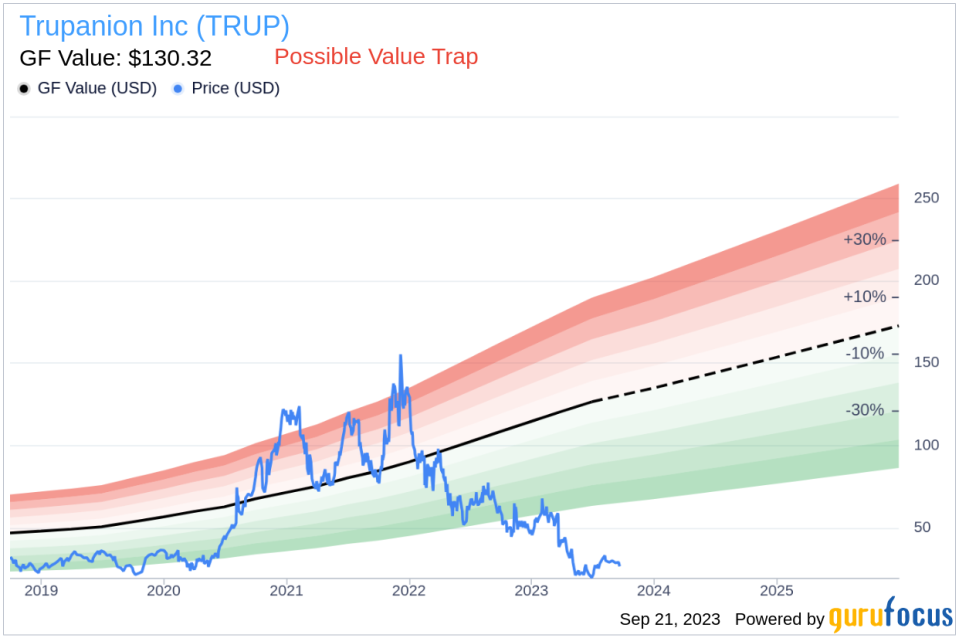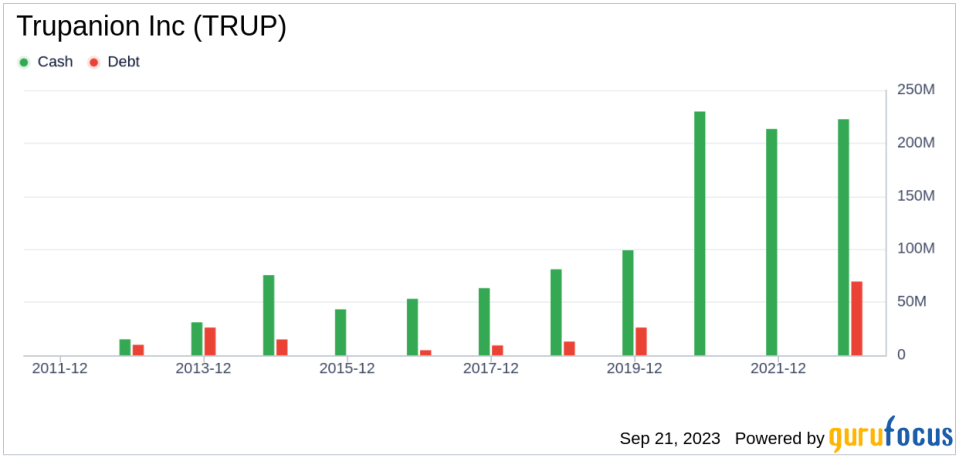Is Trupanion (TRUP) Too Good to Be True? A Comprehensive Analysis of a Potential Value Trap
Value-focused investors are always on the hunt for stocks that are priced below their intrinsic value. One such stock that merits attention is Trupanion (NASDAQ:TRUP). The stock, which is currently priced at 26.61, recorded a loss of 10.07% in a day and a 3-month increase of 21.89%. The stock's fair valuation is $130.32, as indicated by its GF Value.
Understanding GF Value
The GF Value represents the current intrinsic value of a stock derived from our exclusive method. The GF Value Line on our summary page gives an overview of the fair value that the stock should be traded at. It is calculated based on three factors:
1. Historical multiples (PE Ratio, PS Ratio, PB Ratio and Price-to-Free-Cash-Flow) that the stock has traded at.
2. GuruFocus adjustment factor based on the company's past returns and growth.
3. Future estimates of the business performance.
If the stock price is significantly above the GF Value Line, it is overvalued and its future return is likely to be poor. On the other hand, if it is significantly below the GF Value Line, its future return will likely be higher.
Delving Deeper: The Risks of Trupanion
However, investors need to consider a more in-depth analysis before making an investment decision. Despite its seemingly attractive valuation, certain risk factors associated with Trupanion should not be ignored. These risks are primarily reflected through its low Piotroski F-score of 2. These indicators suggest that Trupanion, despite its apparent undervaluation, might be a potential value trap. This complexity underlines the importance of thorough due diligence in investment decision-making.
What is the Piotroski F-score?
The Piotroski F-score, created by accounting professor Joseph Piotroski, is a tool used to assess the strength of a company's financial health. The score is based on nine criteria that fall into three categories: profitability, leverage/liquidity/ source of funds, and operating efficiency. The overall score ranges from 0 to 9, with higher scores indicating healthier financials. Trupanion's current Piotroski F-Score, however, falls in the lower end of this spectrum, indicating potential red flags for investors.
Company Snapshot: Trupanion Inc (NASDAQ:TRUP)
Trupanion Inc is a specialty insurance products provider in the United States. Its core business is the sale of insurance products tailor-made for pets, especially cats and dogs. It operates in two business segments: The subscription business segment generates revenue primarily from subscription fees related to the Company's direct-to-consumer products and Other business segment is comprised of revenue from other product offerings that generally have a business-to-business relationship and a different margin profile than our subscription business segment, including revenue from writing policies on behalf of third parties and revenue from other products and software solutions.
Analysis of Trupanion's Profitability
Firstly, let's address profitability. One significant component of the F-Score is a positive return on assets (ROA). A closer look at Trupanion's ROA reveals a worrying trend of negative returns. This indicates the company's inability to generate profit from its assets - a fundamental concern for any investor.
Let's delve deeper into Trupanion's financial health by examining the decline in its return on assets (ROA) over the past three years. The data indicates 2021: -6.44; 2022: -6.23; 2023: -8.92, when expressed in percentages. Such a decrease is concerning, as the Piotroski F-Score penalizes companies with lower current ROA compared to the previous period. This ongoing decline highlights another potential risk associated with investing in Trupanion.
Observing the financials of Trupanion, it's important to note that the cash flow from operations over the trailing twelve months (TTM) stands at $-11.55 million, whereas the net income in the same period is significantly higher at $-60.69 million. The Piotroski F-score considers this discrepancy as a potential red flag. The rationale behind this is that a company's operating cash flow is a more direct and less manipulated measure of its cash-generating ability than net income. Net income, while important, is susceptible to accounting treatments and non-cash items which can distort the true cash profitability of the company. If a company consistently shows lower cash flows from operations relative to its net income, it could indicate that the earnings quality is poor and the company might have difficulties sustaining its operations or financing its obligations, a fact which could negatively impact its financial stability and investor confidence.
Leverage, Liquidity and Source of Funds: A Worrying Trend
Assessing the aspect of leverage, liquidity, and sources of funds, Trupanion demonstrates an alarming rise in its debt-to-total assets ratio over the past three years. The provided data shows 2021: 0; 2022: 0.09; 2023: 0.14, expressed as percentages. A higher debt ratio suggests that Trupanion is increasingly financing its assets through debt, thereby escalating its financial risk. The Piotroski F-Score views this as a negative indicator, further cautioning investors about Trupanion.
Examining Trupanion's financial stability, there's a notable decrease in its current ratio over the past three years, as shown by the data 2021: 1.95; 2022: 1.78; 2023: 1.57, which is expressed as percentages. The current ratio is a key indicator of a company's short-term financial health, as it gauges the ability to cover short-term liabilities with short-term assets. A declining current ratio suggests that Trupanion's liquidity and capability to manage immediate financial obligations are deteriorating.
Operating Efficiency: A Darker Picture
Examining the data provided: 2021: 40.14; 2022: 40.74; 2023: 41.38, it becomes evident that Trupanion has seen an increase in its Diluted Average Shares Outstanding over the past three years. This trend signals that the company has issued more shares. While issuing additional shares can provide immediate capital for the business, it can also lead to the dilution of existing shares' value. This dilution occurs because the earnings of the company now have to be divided among a larger pool of shares, which could decrease Earnings Per Share (EPS). Consequently, if the company's earnings don't grow at a pace that matches or exceeds this share increase, it could lead to a reduction in the value perceived by existing shareholders, potentially impacting their investment returns. Hence, while additional share issuance may provide necessary capital, it is important to monitor its impact on shareholder value carefully.
Lastly, concerning operating efficiency, the Piotroski F-score examines changes in gross margin and asset turnover. Regrettably, Trupanion follows a discouraging trajectory with a decrease in gross margin percentage over the past three years, as demonstrated by the data provided: 2021: 15.08; 2022: 14.62; 2023: 11.86 (expressed in percentages). This contraction in gross margin suggests that Trupanion is grappling with either an escalation in the cost of goods sold or dwindling prices - both of which are inauspicious indicators for profitability.
In terms of operational efficiency, another key indicator, Trupanion has unfortunately reported a declining trend in asset turnover over the past three years, as evidenced by the data: 2021: 1.38; 2022: 1.37; 2023: 1.48 (expressed in percentages). Asset turnover measures how effectively a company uses its assets to generate sales, and a decrease in this ratio can indicate a drop in efficiency. This could be due to various factors, such as underutilization of assets or a decline in the market demand for the company's products or services. Consequently, this downward trend in asset turnover implies that Trupanion may need to revisit its operational strategies to improve the utilization of its assets and boost its sales volume.
Conclusion: Trupanion - A Value Trap?
While the Piotroski F-score is not the only lens through which to view a potential investment, it is a robust and comprehensive tool for evaluating a company's financial health. Unfortunately for Trupanion, its current score suggests potential troubles. The company's declining ROA, increasing debt ratio, and deteriorating current ratio all indicate potential financial instability. Furthermore, the rise in its diluted average shares outstanding and the decrease in gross margin percentage and asset turnover all paint a concerning picture of its operational efficiency. These factors combined suggest that Trupanion, despite its seemingly attractive valuation, could potentially be a value trap - a stock that appears to be undervalued but is actually fundamentally flawed. As always, thorough due diligence is crucial before making any investment decisions.
GuruFocus Premium members can find stocks with high Piotroski F-score using the following Screener: Piotroski F-score screener .
This article first appeared on GuruFocus.



